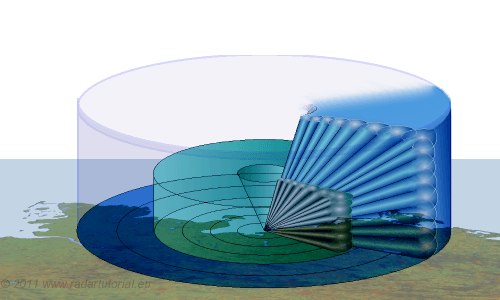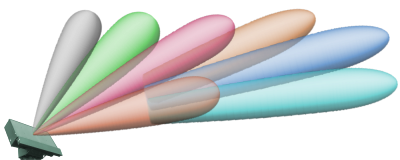Long Range / Short Range

Figure 1: Antenna pattern of a 3D-Radar using Long Range/Short Range templates

Figure 1: Antenna pattern of a 3D-Radar using Long Range/Short Range templates

Figure 1: Antenna pattern of a 3D-Radar using Long Range/Short Range templates

Figure 2: Maximum and minimum range are covered by the dynamic pulse widths

Figure 2: Maximum and minimum range are covered by the dynamic pulse widths
Long Range / Short Range
Recent solid-state transmitters aren't designed to provide a very high pulse power. The reachable pulse-power of transmitter modules in semiconductor technology is limited by voltage, current, and temperature sensitive. Otherwise with the help of the pulse compression method the radar doesn't need so very high pulse power. The frequency-modulated and relatively long pulses provide a respectable range also.
Unfortunately, the long pulse width deteriorates the minimal measuring range. During the transmitting time, the receiver isn't connected with the antenna and cannot work in the event!
To compensate this disadvantage of the long pulses (“long-range-pulses”) the radar can radiate shorter pulses for a dedicated schedule. There are three options for this method:
- A shorter frequency-modulated pulse (also
pulse compressed)
can be transmitted alternately. This method is typically for air-defense radars, which doesn't need a special characteristic in the
minimal measuring range, like the
RRP-117.
This air defense radar uses pulses with a duration of 100 and 800 µs!
- The shorter pulse is an unmodulated very short pulse ( <1 µs).
The limited pulse power causes a shorter maximum range in this period.
This method is typically for air-traffic-control radars (ATC-radars), e.g., the
ASR-E).
- The needed pulse power is dynamically balanced in dependence on the chosen elevation angle. The pulse width determines the maximum range. So this radar gets a stacked beam cosecant-squared antennae pattern by the overlap of a couple of pencil beams.
The following figure is an example of the radar timeline with intrapulse modulated so-called “Long-Range-Pulses” (pulse width: 60 µs) interrupted by three very short peaks (pulse width: 1 µs).

Figure 3: Radar timeline with different pulse widths

range
range
range
Figure 3: Radar timeline with different pulse widths

range
range
range
Figure 3: Radar timeline with different pulse widths
In lower elevation angles, the radar radiates three “Short-Range-Pulses” in series. This is required for pulse-pair processing practicable in close-up range only.
